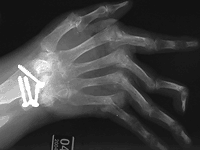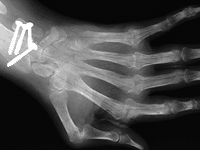Silastic MCP joint replacements had 63% survivorship at 17 years
Performing concurrent crossed intrinsic transfers helped increase the implant survival rate.
![ASSH 2004 New York [icon]](/~/media/images/news/print/orthopedics-today/2004/11_november/assh2004_100_92_1709.gif) A
retrospective study of patients who underwent metacarpophalangeal joint
replacement with silastic implants and were followed up to 17 years found a 63%
success rate with the procedure. Two-thirds of the implants fractured by 15
years’ postop.
A
retrospective study of patients who underwent metacarpophalangeal joint
replacement with silastic implants and were followed up to 17 years found a 63%
success rate with the procedure. Two-thirds of the implants fractured by 15
years’ postop.
In an interview with Orthopedics Today, lead investigator Ian A. Trail, MD, FRCS, commented on results with these silastic implants: “It’s really the success story of joint replacement in the hand, particularly in patients with inflammatory arthritis. … There’s nothing else as good. There are a lot of things being developed at the moment in the hand and if they do as well as that, they’ll do well.”
Since 1979, surgeons have performed 621 metacarpophalangeal (MCP) replacements with 1800 silastic implants at Trail’s institution, Wrightington Hospital in Wigan, England, in patients with rheumatoid arthritis. The researchers analyzed 404 operations using 1336 implants in the study. The data were used to determine implant survivorship and identify those concomitant procedures that might help prolong the life of the implant postoperatively.
|
COURTESY OF IAN A. TRAIL |
Investigators performed a radiographic review to measure any ulnar drift and used the Larsen grading system to determine the extent of the patients’ disease radiographically.
Trail, who presented results at the American Society for Surgery of the Hand 59th Annual Meeting in New York, said: “The implants do quite well, and the patients who have them do very well. When we looked at the x-rays, a lot of the implants were, in fact, broken, but the patients were still pleased.”
Seventy-six implants were revised, 39 of them due to implants that fractured. Other revisions were for joint stiffness, deformity, silicone synovitis, loosening, dislocation and infection.
According to a Kaplan-Meier survivorship analysis conducted by statistician David Nuttall, there was a 70% probability of survivorship of the implants at the 15-year follow-up, taking into account all possible conditions that might lead to a revision surgery.
Unique to this study, Trail said, was a Cox regression analysis and models that identified factors associated with revision and their impact on the surgical outcome, particularly those procedures performed at the same time as the joint replacement. The number of concurrent procedures performed was significant (P=.015).
Implant survivorship increased sixfold when a crossed intrinsic transfer was performed. The model showed 20% greater survival at 15 years postop in those cases. “I think this is the first time it’s been shown that it does have an effect,” Trail said.
During MCP replacement surgery in the ring finger, the intrinsic can be taken off the ulnar side of the middle finger and moved to the radial side of the ring finger. “Instead of pulling the middle finger towards the ulna onto the little finger, it actually acts to pull the ring finger towards the thumb to stop recurrent deformity” and prevent ulnar deviation, he said.
Concomitant thumb procedures increased the risk of implant failure, and if the proximal interphalangeal joint was previously fused, investigators identified a much higher likelihood of implant fracture.
Grommets, which are optional, were originally intended to strengthen the implant designed by Alfred B. Swanson, MD. They were used in a large number of cases in this study but were not associated with any reduction in fracture risk, according to Trail.
The Swanson MCP joint replacement implants are manufactured by Wright Medical Technologies Inc. of Arlington, Tenn.
For more information:
- Trail IA, Stanley JK, Hayton M, Martin J. Long-term survivalship analysis of silastic metacarpophalangeal joint replacement and analysis of failure. #42A. Presented at the American Society for Surgery of the Hand 59th Annual Meeting. Sept. 9-11, 2004. New York.


